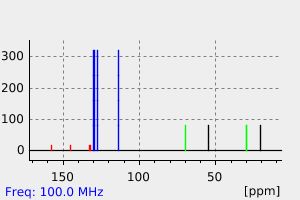1-对甲苯磺酰氧基-3-(4-甲氧基苯基)丙烷 | 88537-43-3
中文名称
1-对甲苯磺酰氧基-3-(4-甲氧基苯基)丙烷
中文别名
——
英文名称
1-p-toluenesulfonyloxy-3-(4-methoxyphenyl)propane
英文别名
3-(4-methoxyphenyl)propyl 4-toluenesulfonate;1-p-tolyl-3-(p-methoxyphenyl)propanesulfonate;3-(4-methoxyphenyl)propyl 4-methylbenzenesulfonate
CAS
88537-43-3
化学式
C17H20O4S
mdl
——
分子量
320.409
InChiKey
NIERMPOKVSQAOE-UHFFFAOYSA-N
BEILSTEIN
——
EINECS
——
-
物化性质
-
计算性质
-
ADMET
-
安全信息
-
SDS
-
制备方法与用途
-
上下游信息
-
文献信息
-
表征谱图
-
同类化合物
-
相关功能分类
-
相关结构分类
物化性质
-
熔点:41-43 °C
-
沸点:477.0±33.0 °C(Predicted)
-
密度:1.179±0.06 g/cm3(Predicted)
计算性质
-
辛醇/水分配系数(LogP):3.9
-
重原子数:22
-
可旋转键数:7
-
环数:2.0
-
sp3杂化的碳原子比例:0.29
-
拓扑面积:61
-
氢给体数:0
-
氢受体数:4
反应信息
-
作为反应物:描述:参考文献:名称:Mohamed, Salah E.N.; Whiting, Donald A., Journal of the Chemical Society. Perkin transactions I, 1983, # 10, p. 2577 - 2582摘要:DOI:
-
作为产物:描述:反式-4-甲氧基肉桂酸 在 吡啶 、 lithium aluminium tetrahydride 、 5%-palladium/activated carbon 、 氢气 作用下, 以 四氢呋喃 、 乙酸乙酯 为溶剂, 20.0 ℃ 、303.99 kPa 条件下, 反应 7.0h, 生成 1-对甲苯磺酰氧基-3-(4-甲氧基苯基)丙烷参考文献:名称:硒酸氰酸酯形成2,3-二氢苯并[b] [1,4]-草酰亚氨酸的合成及机理研究摘要:通过含有硒的杂环的一个适宜的制备米氯过苯甲酸介导的硒代环从硒氰酸盐衍生物开始进行说明。尽管具有重要意义,但实际上不仅从其范围的角度,而且从与这种显着转化有关的机理方面,都对该环化反应进行了研究。从这个意义上讲,在这个有趣的环化反应的不同反应条件下,几种带有芳香环的硒氰酸酯和硫氰酸酯衍生物被评估为底物,从而对其范围以及反应机理的相关信息产生了重要的见解。DOI:10.1055/s-0039-1690800
文献信息
-
烷基烷基砜类化合物及其合成方法和应用
-
Copper-Catalyzed Cross-Coupling between Alkyl (Pseudo)halides and Bicyclopentyl Grignard Reagents作者:Claire Andersen、Vincent Ferey、Marc Daumas、Patrick Bernardelli、Amandine Guérinot、Janine CossyDOI:10.1021/acs.orglett.0c02115日期:2020.8.7The development of a copper-catalyzed cross-coupling between primary and secondary (pseudo)halides and bicyclopentyl Grignard reagents is reported. Highly strained bicyclopentanes can be cross-coupled with a large panel of primary alkyl mesylates and secondary alkyl iodides. The catalytic system is simple and cheap, and the reaction is general and chemoselective.
-
Synthesis of 11C-Labelled Bis(phenylalkyl)amines and Their in Vitro and in Vivo Binding Properties in Rodent and Monkey Brains作者:Shigeki Sasaki、Fumie Kurosaki、Terushi Haradahira、Fumihiko Yamamoto、Jun Maeda、Takashi Okauchi、Kazutoshi Suzuki、Tetsuya Suhara、Minoru MaedaDOI:10.1248/bpb.27.531日期:——Two new 11C-labelled ligands, N-(3-(4-hydroxyphenyl)propyl)-3-(4-methoxyphenyl)propylamine ([11C]2) and N-(3-(4-hydroxyphenyl)butyl)-3-(4-methoxyphenyl)butylamine ([11C]3) were designed based on bis(phenylalkyl)amines (1) which have been reported as polyamine site antagonists with high-selectivity for NR1A/2B NMDA receptors, and radiolabelling of the corresponding phenol precursors with [11C]methyl iodide was readily accomplished. The in vitro inhibition experiments using rat brain slices showed that [11C]2 and [11C]3 share the binding sites with spermine and/or ifenprodil but not with CP-101,606, a highly potent NR2B-selective NMDA antagonist, and that divalent cations such as Zn2+ produced significant inhibition of both [11C]2 and [11C]3 bindings. Intravenous injection of [11C]3 in mice showed almost homogenous distribution throughout the brain. Attempts to block the tracer uptake of [11C]3 by pre-injection with the unlabelled 3 or spermine in rats were unsuccessful, but a small decrease in the cerebral uptake of [11C]3 by co-treatment with the unlabelled 3 was observed in a monkey PET study. The present findings indicate that none of these 11C-labelled analogues have potential for PET study of binding sites on the N-methly-D-aspartate (NMDA) receptors.两种新型11C标记的配体,N-(3-(4-羟基苯基)丙基)-3-(4-甲氧基苯基)丙胺([11C]2)和N-(3-(4-羟基苯基)丁基)-3-(4-甲氧基苯基)丁胺([11C]3),是基于已被报道为高选择性NR1A/2B NMDA受体多胺位点拮抗剂的双(苯基烷基)胺(1)设计的,相关的酚前体与[11C]甲基碘化物的放射性标记相对容易实现。使用大鼠脑切片进行的体外抑制实验显示,[11C]2和[11C]3与精氨酸和/或伊非普利共享结合位点,但不与CP-101,606(一种高效的NR2B选择性NMDA拮抗剂)共享,并且锌离子(Zn2+)等二价阳离子对[11C]2和[11C]3的结合产生显著抑制。对小鼠进行静脉注射[11C]3后,观察到其在大脑中的分布几乎均匀。在大鼠中尝试通过预注射无标记的3或精氨酸以阻止[11C]3的示踪剂摄取未成功,但在猴子的PET研究中观察到无标记的3与[11C]3共同处理时脑内摄取有小幅下降。当前的发现表明,这些11C标记的类似物在NMDA受体结合位点的PET研究中均无潜力。
-
Photocatalyzed site-selective C(sp3)-H sulfonylation of toluene derivatives and cycloalkanes with inorganic sulfinates作者:Shaonan Zhang、Shi Cao、Yu-Mei Lin、Liyuan Sha、Cheng Lu、Lei GongDOI:10.1016/s1872-2067(21)63953-0日期:2022.3The development of practical methods for the direct and selective C(sp3)-H functionalization of hydrocarbons is an attractive topic in synthetic chemistry. Although the radical-mediated hydrogen atom transfer (HAT) process has shown considerable potential in such reactions, it still faces fundamental problems associated with reactivity and selectivity. Herein, we report a convenient and economic approach开发用于烃的直接和选择性C( sp 3 )-H 官能化的实用方法是合成化学中的一个有吸引力的课题。尽管自由基介导的氢原子转移 (HAT) 过程在此类反应中显示出相当大的潜力,但它仍然面临与反应性和选择性相关的基本问题。在此,我们报告了一种方便且经济的位点选择性 C( sp 3 ) -H 磺酰化方法光诱导的 HAT 催化。使用共轭多环醌作为直接 HAT 光催化剂,市售无机亚磺酸盐作为磺酰化源,三氟甲磺酸铜作为廉价氧化剂,多种甲苯衍生物和环烷烃在温和条件下转化为生物和合成有趣的砜产品。机理研究表明,反应顺序涉及直接 HAT 诱导的自由基形成和随后的铜介导的有机金属过程以形成 CS 键。这种方法提供了一个吸引人的机会,可以从丰富的碳氢化合物起始材料和廉价的试剂中提供高附加值的产品。
-
<b>Efficient and Mild Ytterbium(III)-Catalyzed Tosylation of Alcohols</b>作者:Ralf Schirrmacher、Slobodan ComagicDOI:10.1055/s-2004-815998日期:——Ytterbium(III) trifluoromethanesulfonate efficiently catalyzes the reaction of primary and secondary alcohols with toluenesulfonic acid anhydride to yield the alkyl tosylates in high yields. The reactions were carried outunder neutral and mild conditions and product purification was easily achieved by means of short column chromatography.
表征谱图
-
氢谱1HNMR
-
质谱MS
-
碳谱13CNMR
-
红外IR
-
拉曼Raman
-
峰位数据
-
峰位匹配
-
表征信息
同类化合物
(βS)-β-氨基-4-(4-羟基苯氧基)-3,5-二碘苯甲丙醇
(S,S)-邻甲苯基-DIPAMP
(S)-(-)-7'-〔4(S)-(苄基)恶唑-2-基]-7-二(3,5-二-叔丁基苯基)膦基-2,2',3,3'-四氢-1,1-螺二氢茚
(S)-盐酸沙丁胺醇
(S)-3-(叔丁基)-4-(2,6-二甲氧基苯基)-2,3-二氢苯并[d][1,3]氧磷杂环戊二烯
(S)-2,2'-双[双(3,5-三氟甲基苯基)膦基]-4,4',6,6'-四甲氧基联苯
(S)-1-[3,5-双(三氟甲基)苯基]-3-[1-(二甲基氨基)-3-甲基丁烷-2-基]硫脲
(R)富马酸托特罗定
(R)-(-)-盐酸尼古地平
(R)-(-)-4,12-双(二苯基膦基)[2.2]对环芳烷(1,5环辛二烯)铑(I)四氟硼酸盐
(R)-(+)-7-双(3,5-二叔丁基苯基)膦基7''-[((6-甲基吡啶-2-基甲基)氨基]-2,2'',3,3''-四氢-1,1''-螺双茚满
(R)-(+)-7-双(3,5-二叔丁基苯基)膦基7''-[(4-叔丁基吡啶-2-基甲基)氨基]-2,2'',3,3''-四氢-1,1''-螺双茚满
(R)-(+)-7-双(3,5-二叔丁基苯基)膦基7''-[(3-甲基吡啶-2-基甲基)氨基]-2,2'',3,3''-四氢-1,1''-螺双茚满
(R)-(+)-4,7-双(3,5-二-叔丁基苯基)膦基-7“-[(吡啶-2-基甲基)氨基]-2,2”,3,3'-四氢1,1'-螺二茚满
(R)-3-(叔丁基)-4-(2,6-二苯氧基苯基)-2,3-二氢苯并[d][1,3]氧杂磷杂环戊烯
(R)-2-[((二苯基膦基)甲基]吡咯烷
(R)-1-[3,5-双(三氟甲基)苯基]-3-[1-(二甲基氨基)-3-甲基丁烷-2-基]硫脲
(N-(4-甲氧基苯基)-N-甲基-3-(1-哌啶基)丙-2-烯酰胺)
(5-溴-2-羟基苯基)-4-氯苯甲酮
(5-溴-2-氯苯基)(4-羟基苯基)甲酮
(5-氧代-3-苯基-2,5-二氢-1,2,3,4-oxatriazol-3-鎓)
(4S,5R)-4-甲基-5-苯基-1,2,3-氧代噻唑烷-2,2-二氧化物-3-羧酸叔丁酯
(4S,4''S)-2,2''-亚环戊基双[4,5-二氢-4-(苯甲基)恶唑]
(4-溴苯基)-[2-氟-4-[6-[甲基(丙-2-烯基)氨基]己氧基]苯基]甲酮
(4-丁氧基苯甲基)三苯基溴化磷
(3aR,8aR)-(-)-4,4,8,8-四(3,5-二甲基苯基)四氢-2,2-二甲基-6-苯基-1,3-二氧戊环[4,5-e]二恶唑磷
(3aR,6aS)-5-氧代六氢环戊基[c]吡咯-2(1H)-羧酸酯
(2Z)-3-[[(4-氯苯基)氨基]-2-氰基丙烯酸乙酯
(2S,3S,5S)-5-(叔丁氧基甲酰氨基)-2-(N-5-噻唑基-甲氧羰基)氨基-1,6-二苯基-3-羟基己烷
(2S,2''S,3S,3''S)-3,3''-二叔丁基-4,4''-双(2,6-二甲氧基苯基)-2,2'',3,3''-四氢-2,2''-联苯并[d][1,3]氧杂磷杂戊环
(2S)-(-)-2-{[[[[3,5-双(氟代甲基)苯基]氨基]硫代甲基]氨基}-N-(二苯基甲基)-N,3,3-三甲基丁酰胺
(2S)-2-[[[[[((1S,2S)-2-氨基环己基]氨基]硫代甲基]氨基]-N-(二苯甲基)-N,3,3-三甲基丁酰胺
(2S)-2-[[[[[[((1R,2R)-2-氨基环己基]氨基]硫代甲基]氨基]-N-(二苯甲基)-N,3,3-三甲基丁酰胺
(2-硝基苯基)磷酸三酰胺
(2,6-二氯苯基)乙酰氯
(2,3-二甲氧基-5-甲基苯基)硼酸
(1S,2S,3S,5S)-5-叠氮基-3-(苯基甲氧基)-2-[(苯基甲氧基)甲基]环戊醇
(1S,2S,3R,5R)-2-(苄氧基)甲基-6-氧杂双环[3.1.0]己-3-醇
(1-(4-氟苯基)环丙基)甲胺盐酸盐
(1-(3-溴苯基)环丁基)甲胺盐酸盐
(1-(2-氯苯基)环丁基)甲胺盐酸盐
(1-(2-氟苯基)环丙基)甲胺盐酸盐
(1-(2,6-二氟苯基)环丙基)甲胺盐酸盐
(-)-去甲基西布曲明
龙蒿油
龙胆酸钠
龙胆酸叔丁酯
龙胆酸
龙胆紫-d6
龙胆紫







